Book contents
- Frontmatter
- Contents
- Figures
- Introduction
- Part One Motives, Emotions and Development
- Part Two Cultural Practice Motives and Development
- 5 The Development of Motives in Children’s Play
- 6 Developing Motivation through Peer Interaction
- 7 Developing Social Identities and Motives in School Transitions
- 8 Motives Matter
- 9 Motivation for School Learning
- Part Three Creating Conditions for Children’s Engagement
- Index
- References
7 - Developing Social Identities and Motives in School Transitions
from Part Two - Cultural Practice Motives and Development
Published online by Cambridge University Press: 05 November 2011
- Frontmatter
- Contents
- Figures
- Introduction
- Part One Motives, Emotions and Development
- Part Two Cultural Practice Motives and Development
- 5 The Development of Motives in Children’s Play
- 6 Developing Motivation through Peer Interaction
- 7 Developing Social Identities and Motives in School Transitions
- 8 Motives Matter
- 9 Motivation for School Learning
- Part Three Creating Conditions for Children’s Engagement
- Index
- References
Summary
Introduction
One of the major achievements in the cultural-historical and activity approach to human development is the attempt to describe the child in his or her wholeness by approaching the child within its relations to the environment, as a totality, involving always, and at the same time, social, emotional, cognitive and motivational aspects (Leontiev, 1978; Vygotsky, 1982). This wholeness approach involves specifying the transactions between the child and others, and their participation in societal institutional practices in dialogue with the activities, traditions and values within these (Bozhovich, 2009; Hedegaard, this volume; Stetsenko, 2009; Valsiner, 1997).
With a point of departure in the European tradition of social representations theory (Moscovici, 1988, 2001) and the work on the development of social identities that it informed (Duveen, 1997, 2001), the aim in this chapter is to bring this tradition together with a cultural-historical approach in order to enhance our understanding of the development of children’s social identities and motives during school transitions. The cultural-historical approach suggests an explicit account of the role of motives in development, whereas social representations theory offers a conceptualisation of social identities. I argue that these academic traditions can fruitfully complement each other to enhance an understanding of children’s development during institutional transitions. The thesis in this chapter is that different ways of belonging to a peer group directly influence the child’s development of a motive towards learning in school. I show how motive development is connected to social identity processes in a dynamic relationship with institutional demands expressed by adults such as parents and professionals, as well as by peers.
- Type
- Chapter
- Information
- Motives in Children's DevelopmentCultural-Historical Approaches, pp. 115 - 132Publisher: Cambridge University PressPrint publication year: 2011
References
- 2
- Cited by



